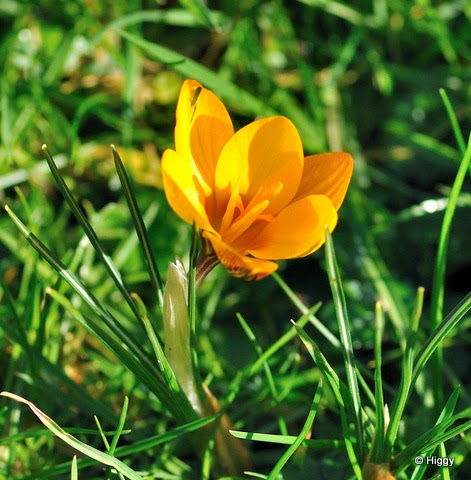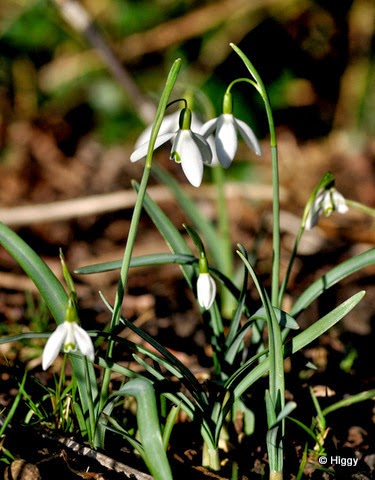Well what a dreadful winter it has been so far! This persistent wet weather has meant that any chance to get out in the garden, let alone do some work has been completely non existent! My problems of not being able to get into the garden do fade into insignificance when you see the news and stories and pictures of the terrible flooding on the Somerset Levels! Not being very far from the dreadful flooding, I'm ammazed of the difference here on the North Somerset Levels, despite being water logged we haven't suffered the flooding like they have there. I really just want to take this opportunity to ask everyone to spare a thought for the residents there, my heart certainly goes out to them and I hope that things sort themselves out faster than is being predicted at the moment!
So back to the garden and I don't have any work to report on except for some inside work planning my next project!
I touched on this in my last post explaining that I wanted to build a much larger wildlife pond within the wildlife / wildflower area of the garden and I shared my initial plans with you then. I'm happy to say that I have continued to keep the planning process going whilst unable to get outside and have a couple more of my rough sketched plans to show you here...
Firstly looking at my proposed site for the pond I need to consider drainage as the garden does get very wet and boggy. With this in mind I decided that whatever type of pond construction I use I would need a way to drain the excess water away from underneath it and have come up with the following idea...
Due to the boggy nature of the garden I will be installing a drainage system under the pond that will drain out into the dry river bed...
As this drain will be draining into the dry river bed and due to it close proximity to the proposed pond this threw up a few other considerations. Firstly the dry river bed actually sits lower in the garden that the proposed pond site. If you have water in the garden and you want it to look as natural as possible you need to think about it's relationship with other features. In this case the water level sitting higher than the river bed, even dry, would look all wrong. This gave me a quandary and after much head scratching I have come up with the below idea...
To make the pond sit naturally higher than the river bed would look wrong, so I have come up with the idea to build a 'false' dam consisting of an old stone wall with false sluice gate! This gives a logical reason for the difference in height as the water level will appear to be held back by the dam..
So with the planning done and the weather still too wet the only progress I have managed to make is to source some 'free to collector' stones for the stone dam...
That really is all I have to report as far as garden projects have gone for the last couple of months! I did however manage to get outside and plant various shrubs, trees and plants for wildlife including...
Alder Buckthorn. Guelder Rose and Wild Cherry in the native wildlife hedge. I also planted a Rowen tree that will provide berries for the birds and an Apple Tree that will provide lovely Spring blossom for pollinators but hopefully a nice crop of fruit for us also!!
Flower wise I have planted several different varieties of Pulmonarias to give nectar for early Spring pollinators and Bees.
Talking of Bees I had a lovely large queen Bumblebee in the garden last weekend and she was taking full advantage of the pollen that we are now trying to provide for early foragers....
Bumblebee - Bombus Terrestris on Winter Honeysuckle Plant (Lonicera fragrantissima)
Following on from this success here are a few of the plants that I have planted exclusively for early Spring pollinators and which are proving very worthwhile additions to the Spring wildlife garden.....
Crocus chry Snow Bunting
Bergenia 'Elephant Ears Purperea'
Crocus Gypsy Girl
Ceanothus
Borage - Borago officinalis
Hellebore
Winter Honeysuckle Plant - Lonicera fragrantissima
Snowdrop - Gilanthus nivalis
I think that gives you a good idea for a few plants that you can grow to provide that vital nectar supply that is a lifeline to early pollinators at this time of the year.
Finally lets have a quick catch up of what's visiting the garden at the moment....
Well again this is quite quiet as there is still heaps of natural food around in the fields and hedgerows and of course we haven't yet had a really cold spell meaning that the birds aren't so reliant of garden feeders.
Despite this the feeders have remained in use and here are a few things that have visited recently...
We have had quite an influx of Magpie recently and they have taken a fond liking to the dried mealworm that we feed at this time of year....
Not everything shows such a warm welcome to the Magpie, often thought of as a pest by some...
The Reed Buntings have once again remained good value and are on the feeders or bird table for most of the day at this time of year...
I have had three separate sightings of ladybirds in the garden this month, showing a real sign that Spring isn't too far away...
Well I think that is about it for this post, not a lot to report but signs that Spring is coming and it can only get better from here on in! I have actually now also managed to secure more rocks, three bags of cement and a dumpy bag full of sand for free so can start my wildlife pond project as soon as the weather allows me to!
A quick edit having written this post last night, I couldn't resist but bring you a picture of a handsome visitor to the garden this morning. It's not that visits from Sparrowhawks are uncommon in fact quite the opposite with several visits in a day sometimes! However this handsome male stopped and actually posed on the shed roof long enough for me to get the camera and take several shots of him!
Although this bird will potentially kill and eat my beloved Reed Buntings it is the balance of nature and everything fits into the food chain at some point. The way I look at it is that by having such wide diversity in the garden from all areas of the food chain is demonstrating just how well 'gardening for wildlife' working!
I will sign off for now and as always give my tanks for following and reading my blog, I do hope that you are all still enjoying it. Hopefully the next time that I log on I will have lots more to tell you about the construction phase of my new projetc and of course more wildlife and plantings for wildlife!
So bye for now and I'll see you all next time!
Best
Higgy


















I don't have much experience growing bergenia, and seeing Purple flowers was a bit of a surprise for me. But I guess it's the right thing to see it as bergenia from your garden flowers as well. Good luck with your project!
ReplyDeleteHi Aga, thank you for your comment. Berginia is grown by most for it's evergreen leaves, hence it's common name of 'elephant ears!' The flowers are really very attractive and look great for several weeks at this time of the year. Early pollinators also love them which is an added bonus! They look good in or by a dried river bed to act as pond Lilly substitutes!
ReplyDeleteThey also propogate by division really well so easy to make further plants!
Best regards
Higgy